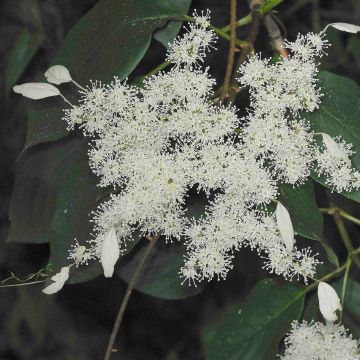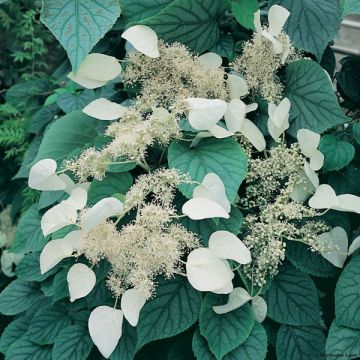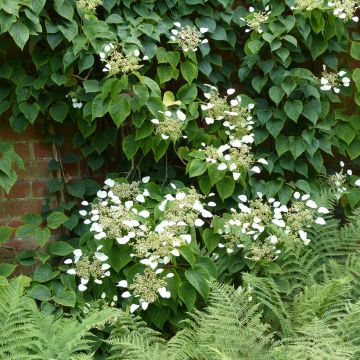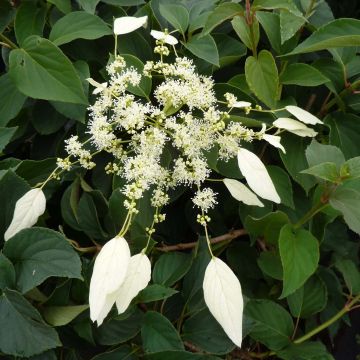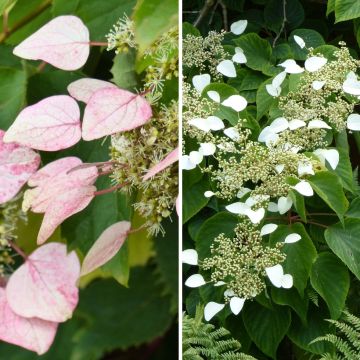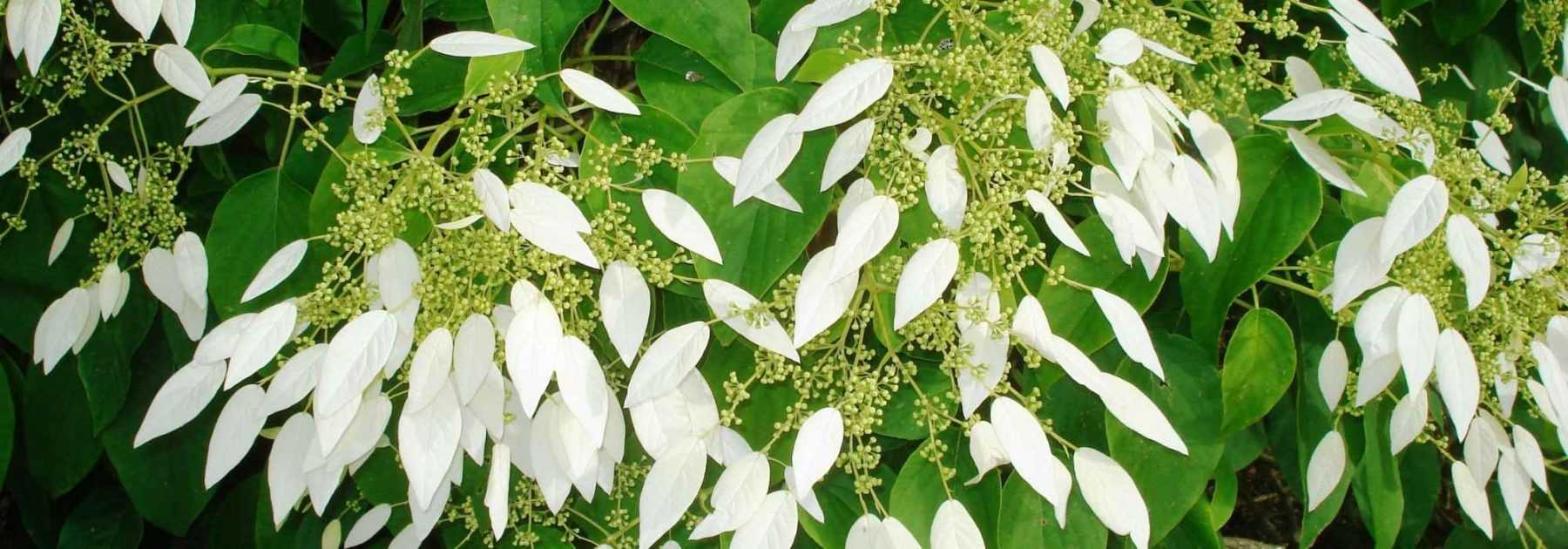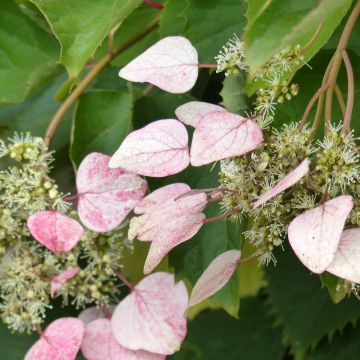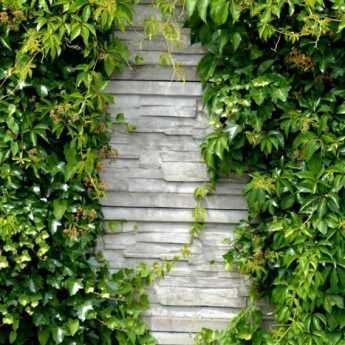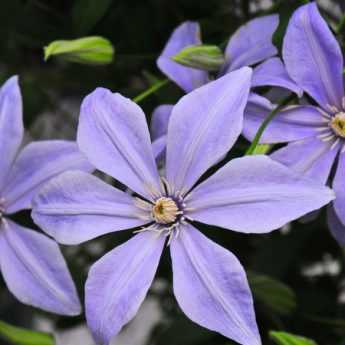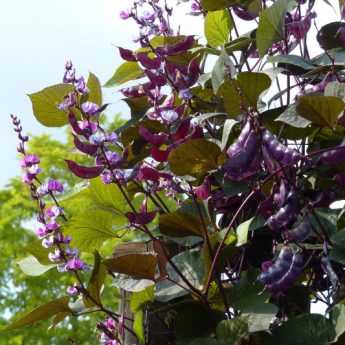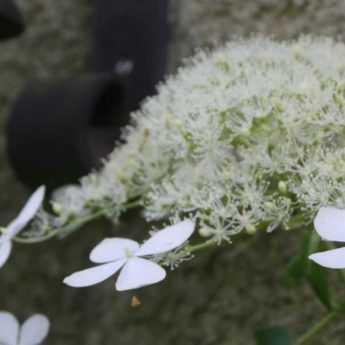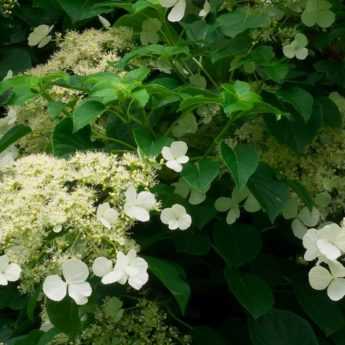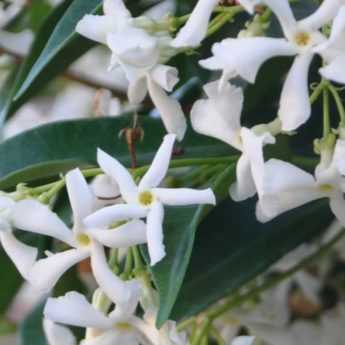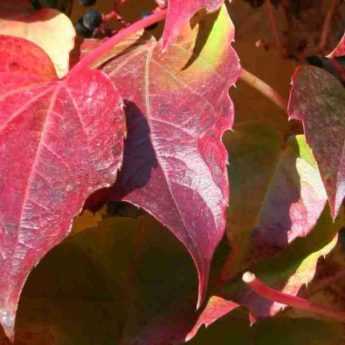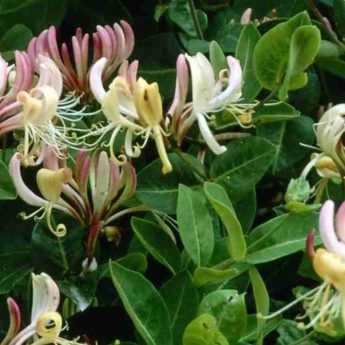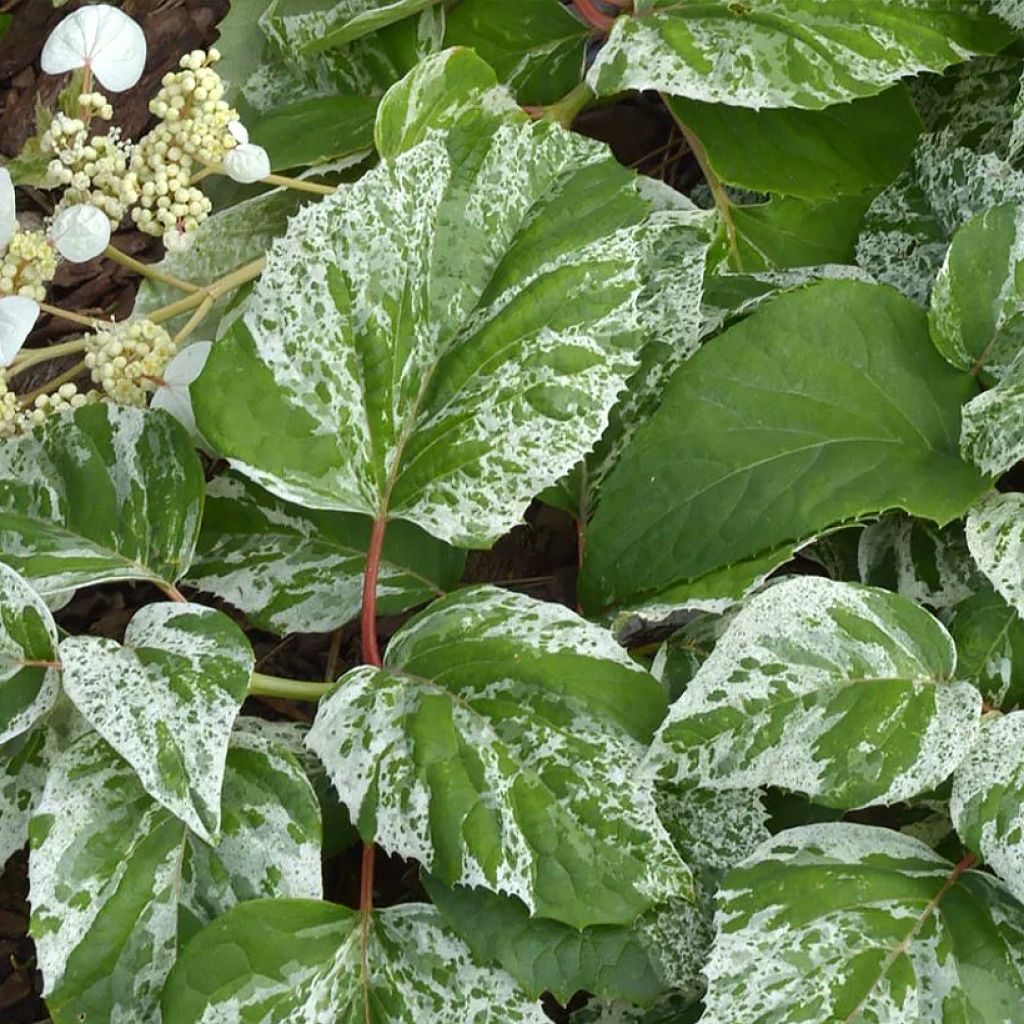

Schizophragma hydrangeoïdes Burst Of Light
Schizophragma hydrangeoïdes Burst Of Light
Schizophragma hydrangeoides Burst of Light
Faux hortensia grimpant, Schizophragme, Hydrangée du Japon
Craquez pour d'autres variétés similaires en stock
Voir tout →Garantie de reprise de 6 mois sur cette plante
Plus d'infos
Nous garantissons la qualité de nos plantes durant un cycle végétatif complet.
Nous remplaçons à nos frais toute plante n'ayant pas repris dans des conditions climatiques et de plantation normales.
A partir de 7,90 € pour une livraison en relais et 6,90 € pour une livraison à domicile
Livraison express à domicile en 24-48h: 8,90 €.
Cette plante est-elle adaptée à mon jardin ?
Je crée mon profil Plantfit →
Description
Le Schizophragma hydrangeoïdes Burst Of Light est un ravissant représentant du groupe des hortensias grimpants. De croissance lente, il peut à terme décorer un mur tout comme garnir un arbre. Avec ses fleurs blanches ressemblant à celles des Hortensias, et surtout son magnifique feuillage vert marbré de blanc, c'est la plante idéale pour éclairer les parties ombragées du jardin. Poussant en climat tempéré, pas trop froid, il apprécie les sols frais à tendance acide, non calcaires. Cette variété récente comblera les amateurs de plantes originales.
Le Schizophragma appartient aux Hydrangeacées, petite famille végétale comptant une dizaine de genres, voire un peu plus selon les classifications botaniques. Dans les jardins, on connait surtout les Hortensias (Hydrangea), riches en espèces d'aspects variés, ainsi que des arbustes à fleurs comme les Deutzia, Philadelphus...
Le Schizophragma hydrangeoïdes est originaire des régions boisées et humides d'Asie, de Chine, de l'Himalaya, du Japon et de Corée. C'est une liane poussant en situation ombragée, et l'une des rares grimpantes fleurissant à l'ombre. On le confond souvent avec l'Hydrangea anomala subsp. petiolaris, l'Hortensia grimpant le plus connu.
Le Schizophragma hydrangeoïdes Burst of Light, en français "éclat de lumière" tire son nom de son feuillage bien lumineux. Cette variété récente a été baptisée et introduite sur le marché en 2016 par une pépinière polonaise qui l'avait sélectionnée au Japon. En 2018, elle a obtenu la médaille d'Or des innovations variétales au Salon du Végétal, le rendez-vous des professionnels des plantes ornementales. De croissance lente (environ 50 cm par an), cette plante convient aux petits jardins. Sa taille maximum est de 6 m de haut pour environ 2,50 m de large, mais il est possible de limiter son développement en la taillant. Grâce à leurs petits crampons, les tiges peuvent grimper sur différents supports, comme un mur ou un tronc d'arbre.
Surtout, le Schizophragma est parfait pour les situations ombragées, là où peu d'autres grimpantes fleurissent correctement. Et enfin, il présente un feuillage caduc magnifique, décoratif toute la saison jusqu'à l'automne. Ses feuilles sont assez grandes, environ 12 à 18 cm de long, serratées (c'est-à-dire que le limbe est garni de dentelures anguleuses) et portées par un pétiole vert à plus ou moins rougeâtre. Pointues à l'extrémité, elles ont une forme deltoïde allongée. Très lumineuses, elles sont vertes, marbrées de façon irrégulière par du blanc crème en proportion variable, si bien que chaque feuille arbore un dessin unique.
En été, ce Schizophragma émet des corymbes de fleurs blanches, pouvant atteindre 25 cm de diamètre, composés de fleurs fertiles jaunâtres au centre, entourées de sépales stériles en périphérie. Ce sont eux qui sont surtout décoratifs, mesurant de 3 à 5 cm, d'une forme triangulaire à extrémités arrondies, et d'un blanc immaculé particulièrement attractif. La floraison dure 2 à 3 mois, de juin à août, et les sépales virent au vert à la fin.
Seul ombre au tableau, le Schizophragma est d'une rusticité moyenne, il se maintiendra difficilement en dessous de - 15°C.
Installez le Schizophragma 'Burst of Light' contre un support, tel le tronc d'un grand arbre, ou un mur à l'ombre. Cette liane peut également courir au sol, à la façon du lierre, il éclairera les lieux délaissés et sombres du jardin. C'est la plante idéale pour grimper le long d'un grand arbre, car il pousse très bien au pied de ceux-ci. Ainsi, un Chêne rouge d'Amérique lui fournira un support puissant pour s'élever et formera un magnifique spectacle à l'automne avec ses couleurs flamboyantes. Le Nyssa sylvatica, ou Gommier noir, qui prospère en sols acides et frais, sera aussi l'occasion de créer une scène rare, pleine de contrastes à l'automne quand cet arbre revêt sa parure rouge orangé.
Port
Floraison
Feuillage
Botanique
Schizophragma
hydrangeoides
Burst of Light
Hydrangeaceae
Faux hortensia grimpant, Schizophragme, Hydrangée du Japon
Horticole
Autres Schizophragma
Plantations et soins
Le Schizophragma hydrangeoides est d'une rusticité moyenne, il se maintiendra difficilement en dessous de - 15°C. Ces plantes n’aiment ni les sols secs et pauvres, ni le calcaire. Au besoin, apportez de la tourbe pour maintenir la fraîcheur (la tourbe ne doit jamais se dessécher complètement, sous peine d'être impossible à réhydrater) et diminuer le pH de votre sol. Plantez-le en automne ou au printemps.
Creusez un trou d’au moins 50 cm de profondeur, dans lequel vous mélangerez du terreau de plantation avec un peu de tourbe, et de la corne broyée à la terre d’origine. Un sol riche en humus, argileux, frais, mais bien drainé est idéal. L'exposition qui convient le mieux est la mi-ombre. En région nord, vous pouvez toutefois les placer au soleil, mais en abritant le pied des rayons directs. Évitez les zones trop brûlantes et le soleil couchant. Des apports d’engrais réguliers seront bénéfiques à cette plante gourmande. De même, un tuteurage est nécessaire jusqu’à une bonne accroche des racines aériennes. On taillera légèrement à la fin de l’hiver pour supprimer les fleurs fanées de la saison précédente, afin de ne pas provoquer de blessures durant les grands froids. Éventuellement, supprimez les tiges rebelles ou enchevêtrées en automne.
Quand planter ?
Pour quel endroit ?
Soins
Nos conseils plantation et soins
Cet article n'a pas encore reçu d'avis; soyez le premier à partager votre expérience.
Vous n'avez pas trouvé votre bonheur ?
La rusticité est la température hivernale la plus basse qu'une plante puisse endurer sans subir de dommages sérieux, voire mourir. Cette rusticité est toutefois affectée par l'emplacement (zone abritée, comme un patio), les protections (voile d'hivernage) et le type de terre (la rusticité est améliorée par un sol bien drainé).

Conditions Générales d'Utilisation du Service Photos Client
Dans le but de favoriser l’interaction et le partage d'expériences entre jardiniers, Promesse de fleurs propose différents services permettant le dépôt de contenus sur son Site – via notamment le module « Partage de photos».
L’Utilisateur s’interdit de:
- Publier tout contenu illégal, préjudiciable, injurieux, raciste, incitant à la haine, révisionniste, contraire aux bonnes mœurs, portant atteinte à la vie privée ou portant atteinte aux droits privatifs de tiers, notamment le droit à l’image des personnes et des biens, le droit de propriété intellectuelle ou le droit au respect de la vie privée
- Déposer des contenus pour le compte d’un tiers
- Usurper l’identité d’un tiers et/ou publier toute information personnelle d’un tiers
D'une manière générale, l’Utilisateur s’engage à s’abstenir de tout comportement contraire à l’éthique
L’ensemble des Contenus (notamment textes, commentaires, fichiers, images, photos, vidéos, œuvres, etc… ), éventuellement soumis à des droits de propriété, propriété intellectuelle, droit à l’image ou autre droit privatif restent la propriété de l’Utilisateur, sous réserve des droits limités accordés par la licence définie ci-dessous à Promesse de fleurs. Les Utilisateurs sont libres de publier ou non de tels Contenus sur le Site via notamment le service « Partage de photos » et acceptent que ces Contenus deviennent publics et librement accessibles notamment sur Internet.
Ils reconnaissent, s’engagent et garantissent disposer de l’ensemble des droits et autorisations nécessaires pour une telle publication sur le Site, notamment au titre de la législation en vigueur et des droits au respect de la vie privée, de propriété, de la propriété intellectuelle, à l’image, des contrats ou de toute autre nature. Par une telle publication sur le Site, les Utilisateurs ont conscience d'engager leur responsabilité en tant qu'éditeur du Contenu au sens de la loi, et accordent sur le dit Contenu, pour toute la durée de publication, à Promesse de fleurs, une licence non exclusive, gratuite, mondiale, incluant les droits de reproduction, de représentation, de chargement, d’affichage, d’exécution, de transmission, de stockage.
Les Utilisateurs autorisent également que leur nom puisse être associé au Contenu et acceptent que cette association ne soit pas toujours faite.
Par leur publication, les Utilisateurs autorisent qu'un Contenu puisse devenir automatiquement accessible sur internet, notamment sur d'autres sites et/ou blogs et/ou pages web du site Promesse de fleurs incluant notamment les pages des réseaux sociaux et le catalogue de Promesse de fleurs.
Les utilisateurs peuvent librement obtenir le retait des contenus confiés, en contactant le service client via le formulaire de contact

































